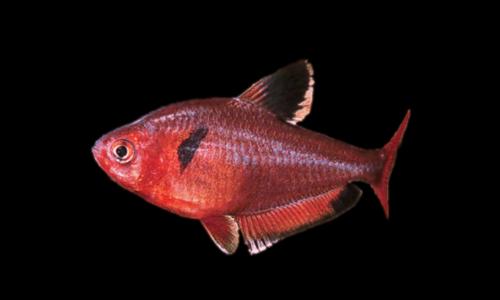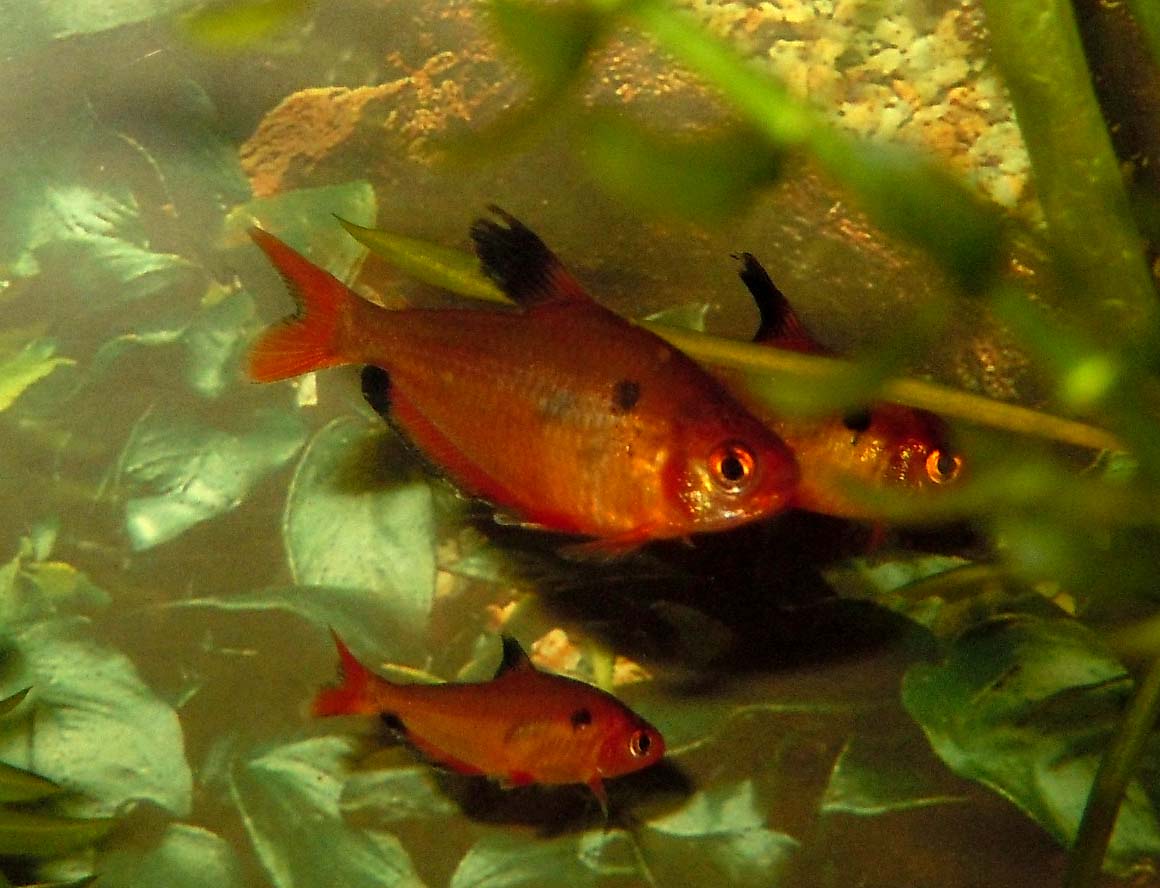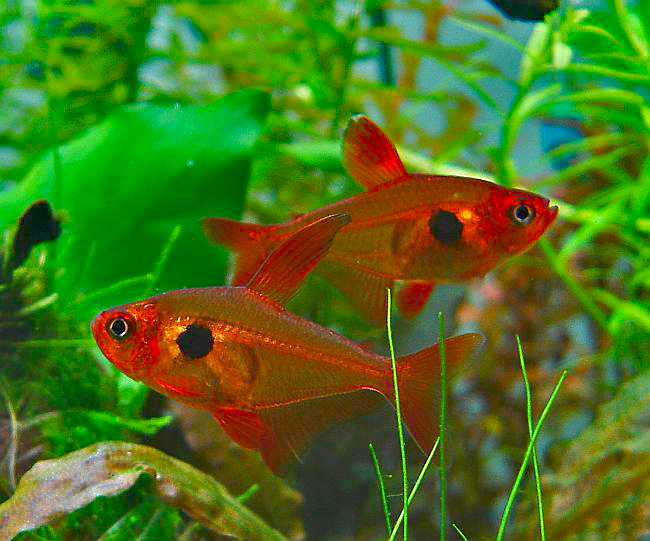I visited the same store today and noticed that in addition to their 'Red minor tetras' they also had a tank of 'White-finned rosy tetras' (Hyphessobrycon bentosi), and that these fish matched what I had. So, I wondered, were my original fish mislabelled? And what were these fish?
First problem was that name: white-finned rosy tetras. Google around and you find 'Rosy tetras' (Hyphessobrycon rosaceus) which look a fair bit like these fish, and 'Ornate tetras' (Hyphessobrycon bentosi). So do I give Petsmart the benefit of the doubt and trust their ID of H. bentosi (though it's noteworthy that their website, unlike the store, doesn't appear to attach a species name at all to the 'White-finned rosy tetras') or should I follow the more common result on Google and assume that they're H. rosaceus?
Unsure how to proceed, I decided to get a sense of the genus Hyphessobrycon. The Wikipedia article on the genus notes that there are over 100 species (as of 2005), but only a handful of these have Wikipedia articles. That said, the coverage of commonly kept aquarium fish is pretty decent, so I decided to see how well I could match my fish with those covered.
Some of them were easy to dismiss as candidate species. Hyphessobrycon columbianus, the Colombian tetra, is described as being silver-grey in colour with a turquoise tinge from the lateral line upward. Several others were also easy to dismiss: H. herbertaxelrodi (the Black neon tetra), H. heterorhabdus (the [Belgian] Flag tetra), H. megalopterus (the Black phantom tetra) H. anisitsi (the Buenos Aires tetra) and H. pulchripinnis (the Lemon tetra) are all easy to rule out; they look nothing like these fish. But that still leaves quite a few candidates (among the species with Wikipedia articles) that required closer examination.
Ember tetra) appears to have a narrower body and smaller fins. The Flame tetra (Hyphessobrycon flammeus) has the right body shape, but has a pair of vertical bars. My fish also lack the prominent red spot associated with the Bleeding heart tetra (H. erythrostigma). This left five reasonable candidates: H. bentosi, H. eques, H. minor, H. rosaceus and H. sweglesi. These five deserved more careful examination.
My fish (Hyphessobrycon sp.)
My fish are orange-red tetras with a relatively thick body. The dorsal fins are back with white edging; the forward third of the dorsal fins are also white or red. Only one of them has the red 'comma' mark typical of Serpae tetras (though apparently not invariably present.
Hyphessobrycon eques (Serpae tetra)
This was, after all, my first guess. The best argument against my fish being Serpaes is the fact that one of them clearly is, and he looks different from everyone else.
Hyphessobrycon minor (Minor tetra)
Given that these fish were labelled 'Red minor tetras' in the pet store, you'd think that 'Minor tetras' would be a very good guess for the identity of these fish. The problem is that this week, in addition to the 'White-finned rosy tetras' they also had a tank of 'Red minor tetras'. And in fact, these appeared to be Serpaes. That said, of course, assuming that the following image is correctly identified, it would be easy to confuse the two.
Finding anything about these fish via Google is nearly impossible, since searches for 'Minor tetra' is going to be subsumed into searches for 'Red minor tetra'. The main distinguishing factor I can find is size, and since these fish are not fully grown, it isn't the most helpful.
Hyphessobrycon sweglesi (Red phantom tetra)
Another fish that looks very like a Serpae tetra, but this time with an even bigger spot behind the gills.
Hyphessobrycon bentosi (Ornate tetra)
The tank I saw today at Petsmart was labelled 'White-finned rosy tetras' (Hyphessobrycon bentosi). They looked a lot like the fish I bought, but that doesn't mean they are the same.
Assuming that these pictures are correctly identified, the most notable difference (other than the body colour, which can wash out in stressed fish) is the lack of a black spot at the far end of the anal fin. Animal-World has the following to say about distinguishing these tetras from H. rosaceus (the Rosy tetra).
Hyphessobrycon rosaceus (Rosy tetra)
This brings us to our final candidate, the Rosy tetra. After all, the fish today were labelled as 'White-finned rosy tetras'.
Problems begin with the descriptions of the species. From Wikipedia
Conclusions?
So what do I have? I don't know. Only the Serpae tetras and the Minor tetras had the black spot on their anal fin in any of the pictures, but sadly none of the species descriptions matched them at all. All I know right now is that I have some sort of Blood tetras. Beyond that, I'm still uncertain.
Unsure how to proceed, I decided to get a sense of the genus Hyphessobrycon. The Wikipedia article on the genus notes that there are over 100 species (as of 2005), but only a handful of these have Wikipedia articles. That said, the coverage of commonly kept aquarium fish is pretty decent, so I decided to see how well I could match my fish with those covered.
Some of them were easy to dismiss as candidate species. Hyphessobrycon columbianus, the Colombian tetra, is described as being silver-grey in colour with a turquoise tinge from the lateral line upward. Several others were also easy to dismiss: H. herbertaxelrodi (the Black neon tetra), H. heterorhabdus (the [Belgian] Flag tetra), H. megalopterus (the Black phantom tetra) H. anisitsi (the Buenos Aires tetra) and H. pulchripinnis (the Lemon tetra) are all easy to rule out; they look nothing like these fish. But that still leaves quite a few candidates (among the species with Wikipedia articles) that required closer examination.
Ember tetra) appears to have a narrower body and smaller fins. The Flame tetra (Hyphessobrycon flammeus) has the right body shape, but has a pair of vertical bars. My fish also lack the prominent red spot associated with the Bleeding heart tetra (H. erythrostigma). This left five reasonable candidates: H. bentosi, H. eques, H. minor, H. rosaceus and H. sweglesi. These five deserved more careful examination.
My fish (Hyphessobrycon sp.)
My fish are orange-red tetras with a relatively thick body. The dorsal fins are back with white edging; the forward third of the dorsal fins are also white or red. Only one of them has the red 'comma' mark typical of Serpae tetras (though apparently not invariably present.
 |
| Same group of fish. Note the black spot at the distal end of the anal fin (clearly visible in the top fish). |
This was, after all, my first guess. The best argument against my fish being Serpaes is the fact that one of them clearly is, and he looks different from everyone else.
 |
| The black line behind the gills is clearly visible, as is the more intense red. Photo courtesy MiguelCampos, released into the public domain. |
Hyphessobrycon minor (Minor tetra)
Given that these fish were labelled 'Red minor tetras' in the pet store, you'd think that 'Minor tetras' would be a very good guess for the identity of these fish. The problem is that this week, in addition to the 'White-finned rosy tetras' they also had a tank of 'Red minor tetras'. And in fact, these appeared to be Serpaes. That said, of course, assuming that the following image is correctly identified, it would be easy to confuse the two.
 |
| Copyright Yuriy Kvach, licensed under the Creative Commons Attribution-Share Alike 3.0 Unported license. |
Hyphessobrycon sweglesi (Red phantom tetra)
Another fish that looks very like a Serpae tetra, but this time with an even bigger spot behind the gills.
 |
| Courtesy Tsunamicarlos; released into the public domain. |
Hyphessobrycon bentosi (Ornate tetra)
The tank I saw today at Petsmart was labelled 'White-finned rosy tetras' (Hyphessobrycon bentosi). They looked a lot like the fish I bought, but that doesn't mean they are the same.
.jpg) |
| Hyphessobrycon bentosi, Copyright Euripides, licensed under the Creative Commons Attribution-Share Alike 3.0 Unported license. |
 |
| Copyright H. Krisp, licensed under the Creative Commons Attribution 3.0 Unported license. |
These two tetras are so similar in appearance that this fish is commonly known as the False Rosy Tetra. Both have a pink to deep salmon colored body, though this species is a bit more transparent. They also each have darker red markings on their fins. They differ in that the Ornate Tetra always has white tipped fins while the Rosy may or may not, and the Rosy has a black marking or 'flag' on its dorsal fin. Other common names this tetra is known by include White Tip Tetra, White Fin Ornate Tetra, and Bentos Tetra.Not entirely useful, but it does suggest that the paler colour of these fish may not be incidental.
Hyphessobrycon rosaceus (Rosy tetra)
This brings us to our final candidate, the Rosy tetra. After all, the fish today were labelled as 'White-finned rosy tetras'.
| Copyright Aquakeeper14, licensed under the Creative Commons Attribution-Share Alike 3.0 Unported license. |
The rosy tetra has a light pink-white body with red fins, except the dorsal fin which can be black or white, and the caudal fin which is pink-white with two elliptical red spots on it. It has a faint black line from the top of its eyeball through the pupil, to the bottom of the eyeball.Animal-World has this to add
The Rosy Tetra Hyphessobrycon rosaceus is a fun addition to a peaceful community aquarium with other smaller fishes. It has the deep bodied shape of the larger tetras like the Bleeding Heart Tetra. It is also quite pretty with its deep salmon body color highlighted with red accents and bright white tips on the fins.
Conclusions?
So what do I have? I don't know. Only the Serpae tetras and the Minor tetras had the black spot on their anal fin in any of the pictures, but sadly none of the species descriptions matched them at all. All I know right now is that I have some sort of Blood tetras. Beyond that, I'm still uncertain.

2 comments:
If you keep Serpae Tetra keep them in a species specific tank. These guys are vicious fin nippers. They will nip the fins of other Serpae and any other fish that they are living with. In a community tank you are bound to have fish death when you introduce them (unless you have a very very large tank where they can define their territories).
By the by I have exactly the same fish that you have without the black spot behind the gill.
Post a Comment